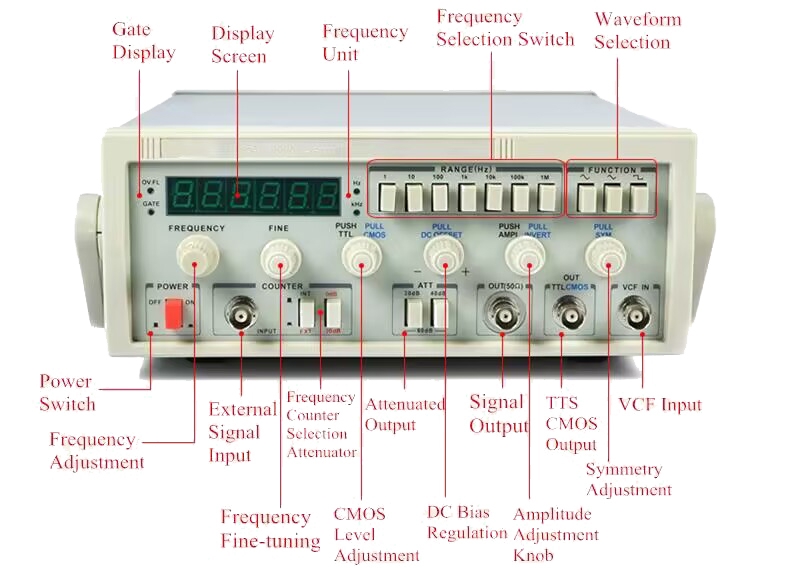A function signal generator is an electronic test equipment used to generate various types of electrical signals, often used in fields such as electronics, communications, measurement, and experiments. Its ability to generate signals of varying frequencies, amplitudes and waveforms provides engineers, scientists and technicians with an efficient way to test and debug circuits, devices and systems.
First, we can start with the term "function signal generator" itself. Among them, "function" refers to a function in mathematics, which represents a mathematical relationship that maps input to output. In a signal generator, this "function" is a mathematical expression that describes the relationship between the output signal and time or other parameters. This expression can be sine, cosine, square wave, sawtooth wave, etc., depending on the user's needs.
What can a function signal generator do?
Function signal generators are versatile electronic devices that can perform various functions in electronic testing, experimentation, and design. Here are some of the key capabilities of function signal generators:
- Waveform Variety: Digital signal generators can produce a range of waveforms, including sine, square, triangular, and sawtooth waves, enabling versatile signal simulations.
- Frequency Adjustment: Users can control the frequency of the generated signal, crucial for testing frequency-dependent behaviors in circuits and devices.
- Amplitude Control: Function generators allow users to adjust the amplitude or voltage of the output signal, facilitating the simulation of signals with different magnitudes.
- Modulation Support: Advanced function generators support modulation functions like frequency modulation (FM), amplitude modulation (AM), and phase modulation (PM), relevant to communication systems and signal processing.
- Precision and Digital Control: Function generators are designed for high precision and stability, often featuring digital controls for easy parameter adjustment, enhancing usability and supporting automated testing.

What are function signal generators used for?
In terms of application fields, function signal generators have a wide range of uses. Some major application fields are expanded in detail below:
- Electronic equipment testing and calibration: Function signal generators are often used to test and calibrate various electronic equipment, including oscilloscopes, spectrum analyzers, amplifiers, etc. By providing signals of specific frequencies and waveforms to the device under test, the performance and accuracy of the device can be evaluated to ensure that it is working properly.
- Communication system testing: In the communication field, function signal generators are used to test radio, fiber optic communications and network equipment. They generate signals that simulate real communications environments, helping engineers evaluate device performance, debug issues, and optimize performance.
- Medical Instruments and Biomedical Research: In the medical field, function signal generators are widely used in the research and development of biomedical instruments, such as electrocardiographs, ultrasound equipment, etc. By providing the functionality to simulate biological signals, these medical devices can be effectively tested and debugged.
- Acoustic research and audio equipment testing: In the audio field, function signal generators are used to test speakers, audio amplifiers, headphones and other audio equipment. By generating sound signals of various frequencies and amplitudes, a device's sonic performance and frequency response can be evaluated.
- Automated System Testing: They also play a key role in automated systems for testing and validating the performance of control systems, and can simulate a wide range of input conditions to ensure that automation systems function properly under a wide range of operating conditions.
- Education and Research: sisco signal generators are often used in education and research in electrical engineering and physics. Students and researchers can use function signal generators to study and experiment with different types of electrical signals and gain insights into the principles of signal processing and electronic circuits.

Choosing a function signal generator depends on your specific needs and application requirements. Here are some factors to consider when selecting it:
- Frequency Range: Evaluate the frequency range of the signal generator. Choose a model that covers the frequencies relevant to your applications. For example, if you need frequencies up to 15MHz, a 0-15MHz digital function signal generator would be suitable.
- Waveform Types: Check the available waveform types. Ensure that the generator supports the waveform types necessary for your testing or experimentation, such as sine, square, triangular, and sawtooth waves.
- Modulation Capabilities: Consider whether your applications require modulation features. If so, choose a generator that offers the necessary modulation capabilities. For instance, the 0-5MHz FM function signal generator is suitable for frequency modulation within a 0-5MHz range.
- Amplitude Control: Assess the amplitude adjustment range and precision. Choose a generator that allows precise control over the amplitude or voltage of the output signal to meet your testing requirements.
- Accuracy and Stability: Look for a generator with high accuracy and stability. These characteristics are crucial for reliable and repeatable testing and experimentation.
- User Interface and Digital Control: Consider the user interface and control options. sisco digital function generator with a user-friendly interface, such as digital displays or panel controls, can simplify operation and setup.
- Budget: Take into account your budget constraints. Compare the features offered by different models within your budget range and choose the one that best aligns with your requirements.
By carefully considering these six points, you can select a function signal generator that meets the specific needs of your applications and provides the necessary features for accurate and efficient signal generation.
The development of function signal generators is also accompanied by the advancement of science and technology. Modern function signal generators are often equipped with digital control and memory functions, allowing users to more easily adjust and save different signal settings. In addition, some advanced signal generators also support modulation technology and can generate modulated signals, such as frequency modulation, amplitude modulation, etc., to meet more complex application requirements.
Overall, function signal generators play an integral role in the field of electronics, providing engineers and scientists with powerful tools for testing, debugging, and researching various electronic and communication systems. The continuous innovation and improvement of its functions will continue to promote the development of the scientific and technological fields.

